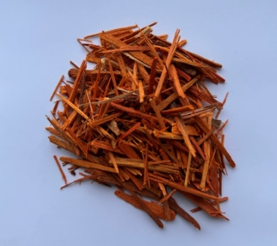- Printed Journal
- Indexed Journal
- Refereed Journal
- Peer Reviewed Journal

Journal of Pharmacognosy and Phytochemistry
Vol. 14, Issue 5 (2025)
Extraction and characterisation of Caesalpinia sappan L. heartwood: A potential pH-responsive colorant for natural cosmetics
Anuja Huddar and Sana Ahmed
Caesalpinia sappan L., commonly known as sappanwood, is a natural source of phenolic pigments exhibiting pH-dependent chromatic transitions. This study focuses on the optimised extraction and characterisation of its heartwood pigment for potential use as a pH-responsive, natural colorant in adaptive cosmetics. Soxhlet extraction using 95% ethanol was employed to isolate the pigment from authenticated, coarsely ground heartwood, followed by solvent evaporation and lyophilization to obtain a powdered extract. The extract demonstrated a characteristic deep red color and underwent distinct hue transitions from yellow-orange to deep redwhen exposed to varying pH conditions. Organoleptic assessment and solubility profiling indicated moderate compatibility with both aqueous and lipid phases, supporting its potential for broad formulation use. Total phenolic content (TPC) and total flavonoid content (TFC) were determined spectrophotometrically, yielding values of 373 mg GAE/g and 7.4 mg QE/g of extract, respectively, suggesting significant bioactive potential. The developed extraction and stabilisation protocol resulted in a reproducible yield of 3.6% w/w. These findings validate the feasibility of C. sappan extract as a bio-derived pigment with tunable color response, laying the foundation for further investigations into its formulation behaviour, stability, and regulatory viability for commercial application. Given its historical acceptance in traditional medicine and food dyeing, this botanical source aligns with the modern demand for sustainable and multifunctional ingredients.

Fig. 1: Sliced heartwood of Caesalpinia sappan L.
Pages: 530-534 | 382 Views 197 Downloads









